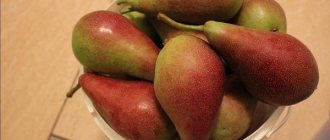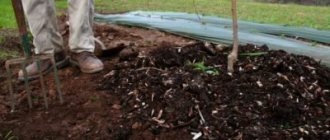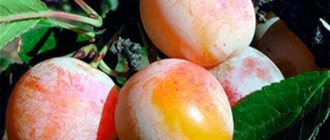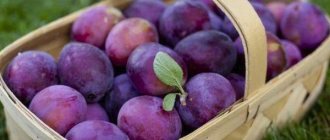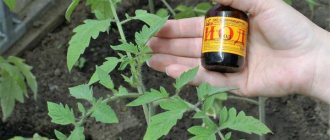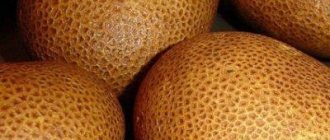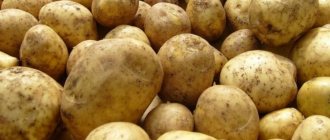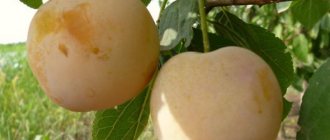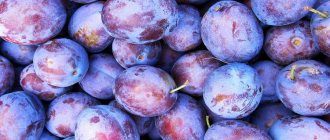Detailed description of the variety
The general plum was bred in the Far East. Therefore, it has excellent frost resistance - down to –50°C. and feels great in the Urals and Siberia.
This is one of the fastest fruiting plums. Its fruiting begins in the 3rd year after planting. As the crown grows, the yield increases. From the age of 5 years, you can collect up to 30 kg of tasty fruits from a tree, and from a 10-year-old - more than 40 kg.
Description of the tree
The plum forms one main trunk, which can reach a height of 6 meters or more. Therefore, in the second year of growth, the top can be trimmed to enhance the formation of lateral fruiting shoots. A spreading crown may be too dense. To provide all branches and fruits with a sufficient amount of sunny color and air, it is thinned out. The root system of a tree is taproot. The lateral roots do not lie too deep - up to 0.5 m deep.
Did you know? Plum
-
a relatively new tree.
It appeared only 2000 years ago as a result of the accidental cross-pollination of blackthorn and cherry plum. The new tree got winter hardiness from the blackthorn, and the cherry plum gave it
delicious, aromatic fruits.
The General plum tree has the following features:
- tree: average height up to 6 m, self-sterile;
- crown: thick, round, spreading;
- flowering: late May;
- Fruiting: late ripening, in mid-September, fruit ripening occurs in 2 waves;
- commercial properties: average, fruits are well stored for 1 month;
- yield from 1 tree: about 30 kg.
Description of fruits
The plum fruit is round in shape, quite fleshy with a small pit. Amber juicy pulp with a traditional sweet and sour taste. It can be used both fresh and for preparing various dishes and homemade preparations. The plum retains its elasticity during preservation and the integrity of its peel, which is greatly appreciated by housewives.
The fruits will ripen until September - the variety is a late ripening variety . But they hardly crumble and can be stored for a long time. Therefore, you can feast on such fruits until the first frost.
Fruit characteristics:
- fruits: large, weighing up to 40 g;
- color: orange, with a red blush if the fruits were in the sun;
- pulp: amber, tender, juicy;
- taste: sweet and sour;
- seeds: small, easily separated;
- skin: strong, smooth.
Did you know? Plum
—
inhabitant of Europe (Prunus domestica) and Asia (Prunus salicina). This tree came to America along with settlers only in the 1860s.
A little history
In the 20th century, breeders living in Siberia and the Far East put a lot of effort into breeding a plum variety that would be adapted to the harsh climate of this particular region. The results turned out to be beyond praise; a large number of varieties have appeared, from which any gardener can choose the one that suits him. Only the most positive characteristics can be given to the general plum. The tree, although small in size, bears fruit well if all recommendations for care and cultivation are followed.
Characteristics of the Generalskaya variety
The variety is unpretentious in cultivation and has a number of undeniable advantages . By choosing the right planting location, you also reduce the likelihood of disease and preserve the harvest. And the adaptability of the seedling to different weather conditions will allow you to get a harvest throughout the entire life of the tree.
Drought resistance, frost resistance
Under natural conditions, the variety tolerates air drought well . As a rule, mature trees are little dependent on watering - they have a sufficiently developed root system to receive moisture from the deeper layers of the soil. The loss of water by a tree during a drought period does not exceed 20%. Therefore, it will easily restore it as soon as watering resumes.
Despite such a useful quality as frost resistance, young seedlings will need reliable shelters. Plums develop good resistance to low temperatures only after 4 years.
A native of the Far East, General plum is capable of growing in the coldest regions . An important characteristic of winter-hardy varieties is that they maintain the declared yield for 20–25 years without deteriorating the consumer qualities of the fruit. To help the tree survive the period of frost, it is planted in an area where there is no stagnation of cold air masses or excess moisture.
Pollinators of Generalskaya plum
Self-sterile varieties of plums need pollinating plants . For this purpose, you need to choose a variety whose flowering occurs at the same time as the main tree. So, the General plum begins to bloom in late May, early June.
Did you know? Plums contain a number of useful components, vitamins and minerals. They are an excellent source of vitamin C, A, K, vitamins B1, B2, B3, B6, B9 and vitamin E. Minerals present in them include potassium, fluoride, phosphorus, magnesium, iron, calcium and zinc.
A companion variety recommended for planting is Ural Red. It coincides in terms of flowering with Generalskaya. For pollination, the distance between trees should not exceed 10 m.
Productivity of the variety
The yield is 30–50 kg per tree, depending on its age and growing conditions.
The following has a great influence on yield:
- damage to the ovaries by pests - plum sawfly or plum borer;
- insufficient lighting - less than 6 hours a day of bright sun;
- spring frosts;
- high soil acidity;
- overly fertilized or unfertilized soil.
The variety is planted next to self-pollinating species
Area of application of berries
Juicy and sweet fruits will find their use both fresh and canned . They are also good in meat sauces, in marinades, as a component of desserts or as a decoration, in pies, salads and other dishes.
Resistance to diseases and pests
The variety is considered moderately resistant to fungal diseases . Therefore, trees need to be treated with a 3% solution of Bordeaux mixture before the buds open.
Did you know? According to Canadian nutritionists, plums have a low glycemic index. Therefore, their consumption can reduce the risk of developing type 2 diabetes and also regulate blood sugar levels.
After harvesting, it is necessary to remove fallen leaves and dry branches from the garden to destroy places where pests can overwinter.
But fungal spores cannot be completely destroyed in this way. Therefore, all antifungal treatments must be fully carried out for the tree .
Preventive treatment of trees
With the onset of spring, it is necessary to carry out sanitary measures on the site. Trees must be treated against common diseases. In addition, it is necessary to destroy pests with larvae that could survive the frost. Such work contributes to obtaining a good harvest.
If there are wounds on the trunk of a plum tree, they should be thoroughly cleaned, then washed with a disinfectant (in this case, 3% copper sulfate works well) and covered well with garden varnish.
Advantages and disadvantages of the variety
- The advantages of plum are:
- high frost resistance;
- drought resistance;
- early onset of fruiting;
- maintaining stability of fruiting for 20 years;
- high and stable yield;
- good taste;
- high commercial properties of fruits.
There are no disadvantages noted in the variety, with the exception of abundant growth that needs to be destroyed. Rather, we can list its features. Thus, compact trees are not intended for industrial cultivation of plums - their yield is not too large for this. But this property is an advantage for a private garden. It is convenient for you to harvest and it is convenient to process such a volume of fruits.
Rules for planting Generalskaya plum seedlings
You can plant plums in early spring and autumn, no later than October. Generalskaya is a frost-resistant variety, so its seedlings can be planted in the fall. They can overwinter with a poorly developed root system.
Plum propagation is possible in 2 ways:
- from a seed;
- a seedling.
Important! Plums should not be planted next to bushes.
Powerful roots of trees hamper the development of the root system of bushes, which can ultimately cause their death. Seedlings are obtained from the mother rhizome, onto which a branch of the desired variety is grafted . The second method of propagation guarantees that you will definitely get the plum you like. Growing from seeds is not practiced, since most modern varieties are hybrids. And a seedling from a seed can take the best qualities from its parent varieties, or it can become infertile.
Before making a purchase, young trees must be carefully inspected so that they are free of defects (dry branches, rot on the roots, traces of lichen, traces of a cut branch)
Timing and choice of landing site
In the spring, planting holes are prepared as soon as the threat of the last frost has passed . And in the fall, planting is possible in September or October. The air temperature on the day of planting should not be below +12°C.
Late varieties of plums also include:
Rules for caring for plums of the Generalskaya variety
After planting, the seedling is provided with conditions for optimal development. It will need regular watering, periodic weeding, loosening the soil to improve air flow to the roots, crown molding, fertilizing and disease and pest prevention. In the fall, you will also need to prepare your plums for winter.
Prevention and protection against pests and diseases
Trees cannot be 100% protected from pest attacks, but the farmer can significantly reduce their population and take measures to create conditions unfavorable for pests. In relation to fruit trees, you can give preference to environmentally friendly methods of control, but more often they are combined with chemical treatment of trees.
Find out more about plum diseases and how to combat them.
Main methods of prevention:
- Crown thinning . Having free space around each branch reduces humidity and does not shade the branches, which is unfavorable for insects.
- Removing organic residues from the garden in the fall is a measure aimed at reducing wintering sites for pests.
- Hanging bird feeders in the winter will attract birds to kill insects in the garden in the spring.
- Spraying trees in early spring with strong-smelling compounds - wormwood, pine needles - disorients insects.
- Installation of pheromone-based insect traps . The smell attracts males. Stuck moths will not be able to fertilize future offspring. This results in a population reduction of more than 30–40%.
Pests are controlled with all kinds of insecticides. The first spraying is carried out before the buds open, the second - before flowering and then, as necessary.
Important! Spray plums in dry weather with no wind. This is necessary so that the solution gets onto the tree and is not carried away by the wind.
The fight against fungal diseases is carried out with fungicides:
- the first treatment before buds open is carried out with 3% copper sulfate;
- the second before flowering - 15% karbofos solution;
- the third - with a solution of "Aktara" or "Confidor" after the plum has faded.
Watering frequency
Watering a young seedling after planting is carried out 2-3 times a week . Then during the first three years of growth - 1 time per week. And an adult plum is watered once a week or less. When watering, you need to wet the soil to a depth of 0.4 m along the diameter of the crown.
Water the tree only in spring and summer . In the fall, in mid-October, watering is stopped and the tree begins to prepare for winter. To better saturate the soil, divide the watering into 2 parts, between which there are several hours for the moisture to be absorbed into the soil.
Important! To evenly distribute water in the soil, it is recommended to divide watering into 2 parts: morning and evening.
Feeding scheme
To feed a young tree, use urea (20 g) and ammonium nitrate (25 g) per 1 m² of soil. Mineral fertilizers can be prepared in the form of aqueous solutions and applied along with irrigation. Fertilizer is applied in the spring once a year. When the tree begins to bear fruit, fertilizing is carried out 2 times a year. To do this, you can use the same fertilizers in an amount of 200 g per 1 m².
But before you fertilize, pay attention to the strength of growth . If the growth is less than 20–25 cm, then the tree needs to be fertilized, and if it is larger, then use half the dose or do not fertilize at all. Plum reacts negatively to excess fertilizer.
Pruning and crown formation
Pruning depends on maturity and variety . A young tree is pruned in early spring or winter before the buds open. This is necessary to form the correct crown. A mature tree can be pruned until July. Trees are not pruned during flowering.
You need to form a vase or bowl. This is a shortened central stem and 4 side branches rising up next to it at an angle of 45 degrees. This form provides each branch with maximum illumination and equal conditions for growth and development.
Important! Fruiting of plums begins after 3
–
5 years after landing.
However, productivity begins to decline after 10 years. Therefore, it is recommended to replace plum trees after 20–25 years
, without waiting for their natural old age.
When the plum reaches a height of at least 1 m, the central stem is cut to a height of 60–70 cm above ground level. Make sure there are at least three buds below the cutting point. The branches should reach a length of about 50 cm. Once the form is established, then simply prune the tree, removing damaged or dry branches, as well as those that have borne fruit. Plum fruits are formed on shoots that appeared last year. The harvest from those that have already borne fruit will always be weaker.
Preparing for winter
Preparing for winter involves removing all fallen leaves and branches from the garden. Protecting the root system from frost involves mulching the soil above the roots. This layer will act as insulation, which is important if your region has cold winters.
Basic activities for preparing plums for winter:
- protect the trunk with whitewash from sunburn;
- protect roots from frost by mulching.
If there is a risk of damage to trees by rodents, then a net is installed around the trunk. She will protect him from hares and mice.
Harvest and storage
The harvest will ripen on the tree. Plums cannot ripen when picked. Ripe fruits are easily separated from the branch. Collect them in a container and store in the refrigerator or cool place for 2-3 weeks. The fruits cannot be stored longer. They soften and begin to rot.
We advise you to read why plums rot on trees and what needs to be done.
When choosing a variety to grow, pay attention to the General plum. She has quite a lot of positive qualities. And most importantly, she is completely unpretentious in care. Therefore, grow plums using preventive measures in time, and you will be assured of an excellent harvest.
Reviews
In some reviews, they clarify that the fruiting period does not always coincide with the stated one. Instead of September, it begins to bear fruit in August. Not everyone is happy with this.
Most reviews are positive for the variety. The taste is completely satisfying. Productivity is also not satisfactory. Preventative treatments against codling moths are recommended.
Source
